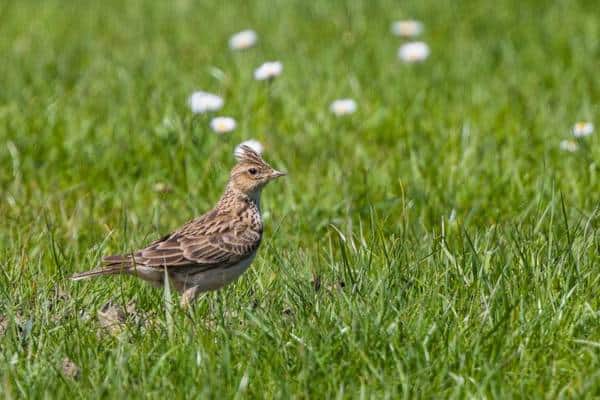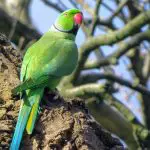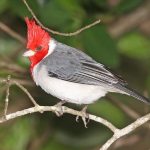Common Name: Eurasian Skylark
Scientific Name: (Alauda arvensis)| Size | Diet | Range in Hawaii | Status in Hawaii |
|---|---|---|---|
| 6.3 in. - 7.5 in. | beetles, flies, caterpillars, ants, and other small invertebrates | O'ahu, Maui, Big Island, Moloka'i, and Lana'i | Least Concern |
The Eurasian Skylark (Alauda arvensis) is a small but impressive bird species that is native to Europe and Asia. With its distinctive brown and white plumage and melodious song, this skylark is a beloved sight and sound in its natural habitat. Although it is not a native species to Hawaii, Eurasian Skylarks have been introduced to the islands and are now naturalized (non-native) residents. They have been established for a long time, and are also occasionally seen as non-breeding visitors or vagrants.
In this article, we’ll explore the fascinating world of the Eurasian Skylark and learn more about its unexpected presence in Hawaii.
Eurasian Skylark
Appearance

The Eurasian Skylark is a small passerine bird with a distinctive appearance. It measures approximately 6.3 to 7.5 inches (16 to 19 centimeters) in length, making it a relatively small bird.
The plumage of the Eurasian Skylark is primarily brown, providing effective camouflage in its natural grassland and agricultural habitats. It has streaked brown upperparts, with darker streaks on its back and wings. The underparts are pale buff or whitish, with dark streaks that become more concentrated towards the breast and flanks.
The head of the Eurasian Skylark features a short crest that can be raised or lowered, depending on its mood. When singing in flight, the crest is often raised, adding to the bird’s distinctive appearance. The bill is short and pointed, adapted for feeding on seeds and insects.
In terms of overall shape, the Eurasian Skylark has a compact and slightly plump body, with short wings and a short tail. Its wings are rounded, allowing it to perform elaborate and melodious flight displays during its breeding season.
Diet
The diet of the Eurasian Skylark consists primarily of seeds and insects. Being a versatile forager, it adapts its feeding habits according to the availability of resources in its grassland and agricultural habitats.
Seeds make up a significant portion of the Eurasian Skylark’s diet, with grass seeds being a preferred food source. It forages on the ground, using its bill to extract seeds from grasses and other plants. During the breeding season, it may also consume the seeds of agricultural crops such as cereals.
In addition to seeds, the Eurasian Skylark feeds on a variety of insects. It actively hunts for insects on the ground, probing the soil and vegetation with its bill. Its insect diet includes beetles, flies, caterpillars, ants, and other small invertebrates.
The Eurasian Skylark’s diet may vary seasonally, with a greater reliance on insects during the breeding season when they provide a vital source of protein for both adult birds and their chicks. Outside the breeding season, seeds become a more prominent part of their diet.
Nesting
The Eurasian Skylark builds its nest on the ground, typically in open grassland or agricultural fields. The nest is constructed by the female skylark, who uses grass, stems, and other plant materials to create a shallow cup-shaped structure.
The female skylark selects a well-hidden spot amidst vegetation to build the nest, providing camouflage and protection from potential predators. The nest is often located in a depression or hollow on the ground, lined with fine grass and occasionally feathers or hair for added comfort.
The female skylark lays a clutch of eggs in the nest, typically numbering three to five eggs. The eggs are light brown or olive in color, with dark speckles or blotches that help to provide camouflage and blend with the surrounding environment.
Both the male and female skylarks take turns incubating the eggs, with an average incubation period of around 11 to 14 days. Once the eggs hatch, both parents are actively involved in caring for the chicks. They feed them a diet of insects and seeds, providing the necessary nutrition for their growth and development.
The young skylarks fledge after approximately 10 to 14 days, although they may still rely on their parents for food and protection for some time after leaving the nest. The Eurasian Skylark typically raises multiple broods during the breeding season, with nests being re-used or new nests constructed for subsequent clutches.
Behavior

The Eurasian Skylark is known for its distinctive and melodious song that it sings while in flight. This small bird is primarily found in open grasslands, agricultural fields, and meadows, where it displays various behaviors.
One notable behavior of the Eurasian Skylark is its vertical singing display. Males ascend into the air, fluttering their wings rapidly, while producing a beautiful and complex song. During this display, they reach impressive heights before descending back to the ground in a series of undulating flights. This behavior is often performed to defend their territory or attract a mate.
Skylarks are primarily ground-dwelling birds, spending much of their time on the ground searching for food. They have a distinctive walking gait and can move swiftly through the grass or fields. They feed on a varied diet consisting of seeds, insects, and occasionally small invertebrates.
When not engaged in singing or foraging, skylarks often rest and preen in open areas or perched on low vegetation. They are social birds and may gather in small flocks outside of the breeding season. However, during the breeding season, they become more territorial and defend their nesting territories vigorously.
Eurasian Skylarks are known for their impressive aerial displays, which include soaring, hovering, and singing while in flight. These displays are thought to serve multiple purposes, such as attracting mates, defending territory, and advertising their presence to potential competitors.
Habitat
The Eurasian Skylark is a bird species that is well adapted to open grassland habitats. It is commonly found in a variety of environments, including agricultural fields, meadows, pastures, and open countryside. It prefers areas with short vegetation, such as mowed grass or grazed land, as it provides suitable foraging and nesting conditions.
These skylarks thrive in habitats that offer a mix of open spaces for foraging and scattered vegetation for cover and nesting. They are particularly well-suited to areas with a mosaic of different grasses and herbaceous plants. The presence of bare ground or patches of exposed soil is also beneficial for their foraging activities.
Eurasian Skylarks can be found in a wide range of elevations, from lowlands to upland areas, as long as the habitat conditions are suitable. They are adaptable birds and can tolerate different types of grassland, including both natural and human-modified landscapes.
It’s worth noting that the availability of suitable habitat greatly influences the distribution and abundance of Eurasian Skylarks. Changes in land use, such as intensive agriculture, urbanization, and the conversion of grasslands to other forms of land use, can negatively impact their populations.
Range
The Eurasian Skylark, a naturalized non-native species, has an established presence in Hawaii. It was introduced to the Southeastern Hawaiian Islands in the 1860s and 1870s, primarily on O’ahu, Ni’ihau, Kaua’i, Maui, Hawai’i Island, Moloka’i, Lana’i, and Kaho’olawe.
Over time, the species has become scarce or disappeared from Kaua’i possibly due to habitat conversion. On the remaining islands, including O’ahu, Maui, Hawai’i Island, Moloka’i, and Lana’i, Eurasian Skylarks continue to thrive and are commonly observed in suitable upland habitats. Vagrant individuals have also been reported in the Northwestern Hawaiian Islands, particularly on Kure Atoll.
Conservation Status

The conservation status of the Eurasian Skylark is assessed globally by the International Union for Conservation of Nature (IUCN). Currently, the Eurasian Skylark is categorized as a species of “Least Concern.” This designation indicates that the species is widespread, abundant, and does not face significant threats that would qualify it for a higher conservation status.
The Eurasian Skylark has a vast geographic range, breeding across temperate regions from Western Europe and North Africa to Siberia and Japan. It undertakes seasonal migrations, with populations moving south to Africa, India, and Burma during the winter months. The species has adapted well to human-altered habitats and agricultural landscapes, which has likely contributed to its population stability and widespread distribution.
Interesting Facts
1. Multiple broods
Skylarks are known for their high breeding productivity. They often have multiple broods within a breeding season, laying several clutches of eggs. This reproductive strategy allows them to maximize their breeding success and population growth in favorable years.
2. Melodious songs
The Eurasian Skylark is famous for its melodious and complex song. Males perform elaborate aerial displays, ascending high into the sky while singing a beautiful song that can last for several minutes. These songs are a prominent feature of their breeding behavior and are used to attract mates and establish territories.
3. Successful introductions
The species has been introduced to various regions around the world with great success. Eurasian Skylarks have established populations in Vancouver Island (Canada), Australia, New Zealand, and several Pacific islands, demonstrating their ability to adapt and thrive in new environments.
4. Name change
The Eurasian Skylark was previously known as the “Sky Lark” by the American Ornithologists’ Union (AOU) from 1995 to 2015. However, in 2016, the AOU reverted to the name Eurasian Skylark to align with worldwide usage.
Frequently Asked Questions
1. How long do Eurasian Skylarks live?
The lifespan of the Eurasian Skylark is typically 2-3 years in the wild, although some individuals have been known to live up to 8 years.
2. Are there any subspecies of Eurasian Skylarks?
Yes, the Eurasian Skylark has several recognized subspecies across its wide distribution range. These subspecies may exhibit variations in size, plumage, or geographic range.
3. Do Eurasian Skylarks have any natural predators?
Eurasian Skylarks face predation from various ground-dwelling predators such as foxes, stoats, weasels, and domestic cats. Birds of prey such as hawks and falcons may also pose a threat.




